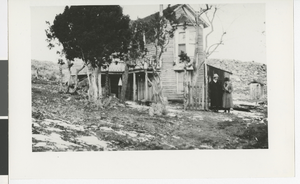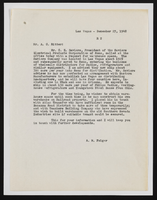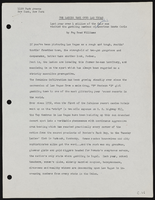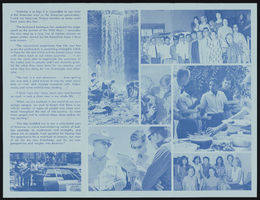Search the Special Collections and Archives Portal
Search Results

Patricia Vazquez interview, November 14, 2018, June 14, 2019: transcript
Date
Archival Collection
Description
Session 1: Interviewed by Marcela Rodriguez-Campo. Barbara Tabach also participates in the questioning. Session 2: Interviewed by Rodrigo Vazquez. Monserrath Hernandez also participates in the questioning. Patricia Vazquez was born and raised in Las Vegas, NV and shares her experiences growing up in the Valley as a Queer Latina. At a young age, she remembers traveling back and forth between Mexico and the U.S. to visit family. When she started school she shares how her home language, Spanish, became her family's "secret language" as she began to learn English. During elementary school Patricia was tracked into the special education program, and remove from the mainstream classroom. She would find her love for learning in books and libraries as she taught herself how to read in English. Despite being tracked into less advanced courses, Patricia would end up taking AP/ Honors courses in high school after forging her favorite teachers signature, which changed her educational trajectory. After coming out to her family, Patricia went nearly a decade distanced from her mother and continued her college education at Arizona State University. There, she would complete a bachelors in painting and a masters in comparative literature. Her work with the Chicano Studies program at ASU helped her develop her Chicana identity and begin her involvement in social activism. In Las Vegas, she worked to fight for marriage equality and LGBTQ rights with the American Civil Liberties Union , and later with the Progressive Leadership Alliance of Nevada. She also conducted several lectures for the Latino Youth Leadership Conference on sexuality, gender, and homophobia for over a decade. She has served as an English Professor at the College of Southern Nevada for the last 20 years and is an avid hiker, traveler, and painter.
Text
Carl Williams oral history interview
Identifier
Abstract
Oral history interview with Carl Williams conducted by Claytee D. White and Kelli Luchs on April 20, 2010 for the Boyer Early Las Vegas Oral History Project. In this interview, Williams discusses attending the Westside School starting in 1949. He recalls the teachers, staff, and describes the buildings as he remembers them. Lastly, Williams discusses activities held at the Westside School, community activities at the time, and his involvement with various churches.
Archival Collection
Barbara Givens oral history interview
Identifier
Abstract
Oral history interview with Barbara Givens conducted by Claytee D. White on October 05, 2005 for the UNLV @ 50 Oral History Project. Givens discusses moving to Las Vegas, Nevada from Reno, Nevada in 1952 and receiving a degree in teaching from what is now the University of Nevada, Las Vegas. She also talks about teaching in two Las Vegas high schools and a class for new teachers at UNLV.
Archival Collection
John W. Steiger Photograph Collection
Identifier
Abstract
The John Steiger Photograph Collection contains black-and-white photographic prints of H. E. Steiger, John Steiger's father, in and around Las Vegas, Nevada in the 1920s. Images depict H. E. Steiger and various other identified and unidentified individuals in various locations surrounding Las Vegas, including Wilson Ranch, Mount Charleston, and Boulder Canyon. Some images of the Las Vegas Grammar School include John Steiger's mother, who was an elementary school teacher in Las Vegas from 1919 to 1920. The majority of items in this collection are digital surrogates, and the donor retains the original items.
Archival Collection

Photographs from the Holocaust Education Seder event at the Rio Hotel, April 6, 2014
Date
Archival Collection
Description
An essay by Esther Toporek Finder accompanying the photographs describes the event: "Holocaust survivors, along with Clark County students and teachers, sat down to break matzo and bread together at Las Vegas? first Holocaust Education Seder Sunday (April 6) at the Rio Hotel. Three generations from the survivor community gathered with middle and high school students and teachers from elementary, middle, and high schools. The leader for the traditional portion of the service was Rabbi Sanford Akselrad and the Shoah segments were led by Professor Esther Finder. Kevin Janison, from MyNews3, served as host and MC. Both Finder and Janison are children of Holocaust survivors. Ray Fiol lit candles on behalf of the approximately six million Jewish victims of the Holocaust and a 7th candle to represent the non-Jewish victims of Nazi atrocity. Music was provided by Cantorial Soloist Lola Rivera. Educator and librarian Susan Dubin shared original poetry as part of the blessing after the meal. Participants dined on foods traditional for Passover: matzo ball soup, roasted chicken with matzo kugel, tsimmis and a non-dairy chocolate dessert."
Image

Photograph of house, Pioche (Nev.), 1910s
Date
Archival Collection
Description
Image



